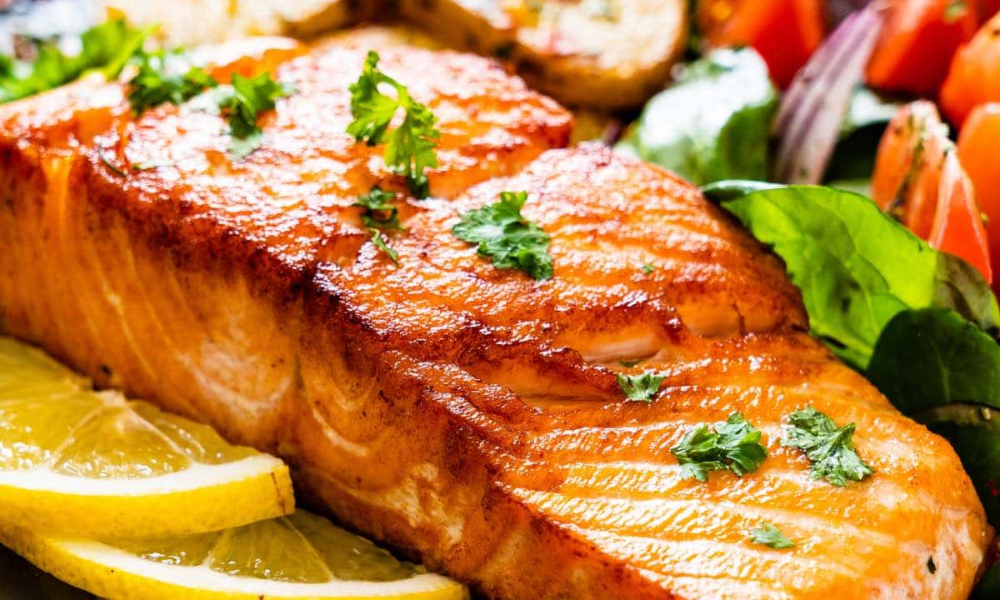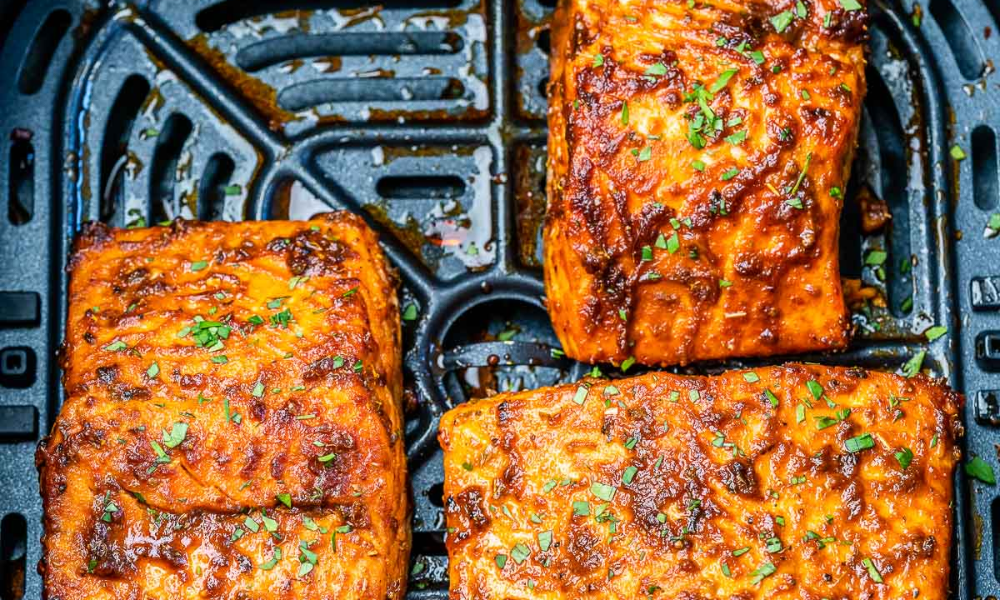Air frying is a convenient and efficient way to cook salmon. The high-heat circulating air in an air fryer creates a crispy, crunchy texture on the outside of the salmon while keeping the inside moist and flavorful. Knowing how long to cook can be helpful if you’re new to air-frying salmon. In this article, we’ll provide some guidelines for air frying salmon and offer tips for ensuring that it comes out perfectly every time.
How Long do I Air Fry Salmon?
Set your air fryer to 400 degrees Fahrenheit before beginning to air-fry the fish. Use a meat thermometer to ensure the salmon has reached 145 degrees Fahrenheit. If the salmon has skin, place its skin side down in the air fryer basket. Depending on the thickness of the fillets, the salmon should be cooked for 8 to 12 minutes., 145 degrees Fahrenheit.
It’s crucial to remember that depending on the size, thickness, and type of air fryer being used, the cooking time for salmon in an air fryer may change. To ensure the salmon is cooked to a safe temperature, it is always a good idea to use a meat thermometer to check its internal temperature.
To account for thawing, you must increase the cooking time for frozen salmon in the air fryer by a few minutes. Before cooking, you might season the salmon with salt, pepper, and other desired herbs or spices. You can also brush oil or marinade over the fish to add flavor and moisture.
Before cooking, it’s a good idea to pat the salmon dry with a paper towel to get rid of any extra moisture.
Please take the salmon out of the air fryer once it has reached the level of doneness you choose and let it rest before serving. The moisture and flavor of the fish will be preserved as a result. Enjoy!
Tips
- Make sure the salmon fillets are all the same size. This will make sure that they all cook at the same time and in the same way. Depending on your air fryer’s size, you may need to cook them in batches. Then, if needed, the thicker ones can be cooked simultaneously.
- How long it takes to cook salmon in an air fryer depends on how thick the pieces are and what air fryer you use. The best way to check is to use a fork and see if it comes off easily. Use a fork to check if the food is done the way you want.
- Once the air fryer is hot, the salmon should be put in it. Doing this will make sure that the salmon is cooked evenly. This cuts down on time it takes to cook and gives the salmon a crisper edge.
- Don’t cram too much into your basket. If you had to, you could air-fry the fish in two batches. Because the moisture from the salmon fillets touching each other can quickly change the hot air circulating the fish, putting them together runs the risk of making the salmon not crispy.
How Long Should I Pan-Fry Salmon?
To cook salmon in a frying pan, follow these steps:
- A large frying pan should be heated to medium-high.
- Put a little butter or oil in the pan.
- Add salt, pepper, and any additional herbs or spices to taste while seasoning the salmon fillets.
- If the salmon has skin, place its skin-side down in the pan.
- The salmon should be cooked on each side for 3 to 4 minutes or until it reaches the required doneness.
- Use a meat thermometer to ensure the salmon has reached 145 degrees Fahrenheit.
It’s crucial to remember that the time it takes to cook salmon in a frying pan might change depending on the size and thickness of the fillets, the type of stove used, and the pan itself. To ensure the salmon is cooked to a safe temperature, it is always a good idea to use a meat thermometer to check its internal temperature.
Remove the salmon from the pan and let it rest for a few minutes before serving once it has reached the doneness you choose. The moisture and flavor of the fish will be preserved as a result. Enjoy!
What to Serve with Salmon?
One of the best combinations of air-fried salmon is with salad. This salad can be prepared ahead of time and served alongside your salmon. Another delicious pairing is with roasted veggies, such as mushrooms or zucchini. A side of mashed or sweet potatoes can also be a great accompaniment. You can also make a vegetable side dish and add the air-fried salmon. There are many other options for side dishes, but these are just a few that go well with air-fried salmon.
Salmon tastes great with salads, so it goes well with just about any side dish. For a more sophisticated meal, you can add a little honey to the mixture and season to taste. If you want to be creative, you can also add a little garlic or paprika to the mix, too. You can also season the fish with a bit of salt and pepper.
To make dill mayo, chop fresh dill weed and combine it with lemon juice and mayonnaise. Another great option is a simple salad with lemon wedges and dill mayo. Another great option is a simple salad with lemon wedges and dill mayo. For a full meal, you can also air fry the salmon with salad ingredients, such as roasted potatoes or sauteed Brussels sprouts. Asian noodle salad or ramen salad is also a great accompaniment.
How do you Store Cooked Salmon and Reheat it?
To store cooked salmon, wrap it tightly in aluminum foil or plastic wrap or place it in an airtight container. Cooked salmon can be stored in the refrigerator for up to 3 days or in the freezer for up to 2 months.
To reheat cooked salmon, you can use the oven, the stove, or the microwave. Here are some general guidelines for each method:
- Oven: Preheat the oven to 350 degrees Fahrenheit. Place the salmon on a baking sheet lined with parchment paper or aluminum foil. Cover the salmon with aluminum foil to keep it moist. Bake for 8-10 minutes or until heated through.
- Stove: Heat a frying pan over medium heat. Add a small amount of oil or butter to the pan. Place the salmon in the pan and cook for 2-3 minutes on each side until heated.
- Microwave: Place the salmon on a microwave-safe plate. Cover the salmon with a damp paper towel. Microwave on medium power for 1-2 minutes or until heated through.
It’s important to be careful not to overcook the salmon when reheating it, as this can cause it to become dry and tough. Always use a meat thermometer to ensure that the internal temperature of the salmon has reached at least 145 degrees Fahrenheit before serving.
Do you have to Flip Salmon in an Air Fryer?
Flipping salmon in an air fryer is generally unnecessary, as the high-heat circulating air cooks the salmon evenly on both sides. However, if you prefer to flip the salmon or cook it in a particularly thick fillet, you can flip it halfway through the cooking time to ensure that it is cooked evenly on both sides.
To flip the salmon in an air fryer, carefully remove the basket and use a spatula to turn the salmon over gently. Return the basket to the air fryer and continue cooking until the salmon is cooked to your desired level of doneness. Use a meat thermometer to ensure that the internal temperature of the salmon has reached 145 degrees Fahrenheit.
It’s important to be careful when flipping the salmon in an air fryer, as the basket and the air fryer will be hot. Use oven mitts or tongs to protect your hands and avoid burns.
Does Air-Frying Salmon Dry it Out?
Air frying salmon can potentially dry it out if it is overcooked or if the air fryer is set to a too high temperature. To avoid drying out the salmon, it’s important to cook it at the proper temperature and for the appropriate amount of time and to use a meat thermometer to ensure that the internal temperature of the salmon has reached 145 degrees Fahrenheit.
You can also help keep the salmon moist and flavorful by seasoning it with salt, pepper, and any other desired herbs or spices or brushing it with oil or a marinade before cooking. Covering the salmon with aluminum foil while it cooks can also help to retain moisture.
How do I Know When the Salmon is Done?
To determine when the salmon is done cooking, use a meat thermometer to check the internal temperature of the salmon. When the internal temperature has reached 145 degrees Fahrenheit, the salmon is fully cooked and safe to eat.
You can also check for doneness by looking for certain visual cues, such as the appearance of the juices and the flakiness of the fish when it is gently pressed with a fork. Remember that the cooking time will depend on the fillets’ size and thickness and the cooking method used.
Conclusion
The omega-3 fatty acids found in healthy salmon are delicious and excellent for decreasing blood pressure and having anti-inflammatory qualities. This recipe for low-calorie salmon is fantastic for a healthy lunch because it contains high-protein fish and no additional carbs.

